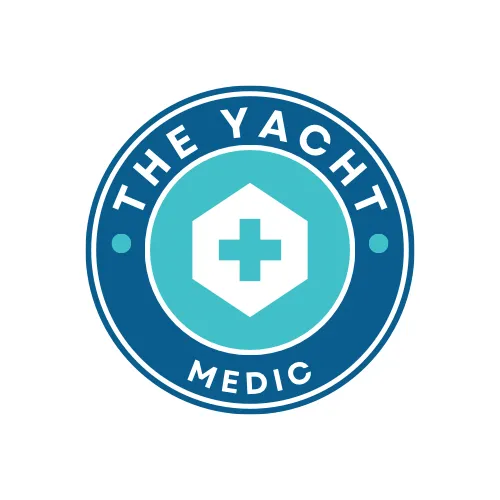See Our Latest Blogs
Beyond Boundaries, Beyond Rescue
Mastering Self Reliance At Sea

Heart Attack on a Yacht, Green Island, Antigua
Managing a Suspected Heart Attack Onboard a Superyacht – The Emergency Management Plan Every Crew Should Know
What happens when a guest suffers a suspected heart attack onboard your yacht, hundreds of miles from the nearest hospital?
This is one of the most serious medical emergencies a superyacht crew can face. Your team’s response in the first few minutes will determine the outcome—whether the guest survives, deteriorates, or goes into cardiac arrest.
In this post, I’ll walk you through a clear, professional Emergency Management Plan (EMP) for handling a heart attack onboard—designed for superyacht crews operating in remote, high-stakes environments.
1. Scene Safety & Situation Control
Action:
• Secure the area—remove bystanders, check for hazards
• Assign crew roles immediately: first aid lead, communicator, support
• Keep the deck clear for potential CPR
Why:
Managing the scene prevents panic, reduces risks to the casualty and crew, and ensures a focused, structured response.
2. Initial Casualty Assessment (DRCABC)
Action:
• Danger: Ensure the scene is safe
• Response: Assess level of consciousness (AVPU scale)
• Airway: Is it clear?
• Breathing: Check if the casualty is breathing normally
• Circulation: Look for signs of shock (pale, clammy skin, weak pulse)
Why:
A rapid assessment tells you if the casualty is still responsive or has already gone into cardiac arrest. It also prevents you from missing early signs of deterioration.
3. Identify the Signs of a Heart Attack
What to Look For:
• Chest pain or discomfort (tightness, pressure, squeezing)
• Pain radiating to jaw, neck, arms
• Shortness of breath, nausea, sweating
• Pale or grey skin tone
• Anxiety, sense of impending doom
Why:
Early recognition buys you time to treat and possibly prevent cardiac arrest. Some guests—especially men—minimize symptoms. Stay alert.
4. Immediate First Aid Treatment
Action:
• Call for the medical kit and AED immediately
• Give 300mg aspirin (if conscious and not allergic) – have them chew slowly
• Apply high-flow oxygen (15L/min) if available
• Position the guest half-sitting to ease strain on the heart
• Monitor oxygen saturation, breathing, and pulse continuously
Why:
Aspirin reduces clot formation. Oxygen reduces the workload on the heart. Positioning keeps the casualty comfortable and improves oxygenation.
5. Send for Help – Activate Medical Protocols
Action:
• Inform the Captain immediately
• Activate your yacht’s Accident and Medical Management Plan
• Call Telemedicine support (MSOS, THEMIS, MedAire)
• Prepare for possible medevac or diversion
• Record observations, times, and all actions taken
Why:
Time is critical. Getting expert medical advice early ensures you’re following the latest protocols and ready to escalate to evacuation if needed.
6. Prepare for Cardiac Arrest – Be Ready for CPR/AED Use
Action:
• Have the AED ready and place pads per protocol
• Assign CPR roles and clear deck space
• Be prepared for sudden deterioration
Why:
Heart attacks can deteriorate fast. Studies show survival improves drastically if an AED is ready and CPR is initiated without delay.
7. Reassure the Guest – Psychological First Aid Starts Now
Action:
• Speak calmly and explain every action
• Never leave the casualty alone
• Manage the guests/family on scene sensitively
Why:
Fear worsens cardiac workload. A calm, confident crew reassures the casualty and maintains control of the scene.
8. Ongoing Monitoring and Decision-Making
Action:
• Reassess every 5-10 minutes
• Watch for unconsciousness or erratic breathing
• Prepare for onboard care or handover to medical professionals
Why:
Heart attack casualties are unstable. Continuous monitoring ensures you don’t miss the moment they slip into cardiac arrest.
Why This Plan Matters for Superyacht Crews
A suspected heart attack is not just a medical emergency—it’s a leadership challenge.
✔ Early aspirin and oxygen save lives
✔ Preparation for deterioration prevents panic
✔ Telemedicine support aligns with MCA and industry best practice
✔ Psychological support for crew and guests begins in the moment
On a superyacht, you are the frontline medical team.
Your structured response—calm, prepared, and by the book—makes the difference between a guest surviving or becoming a casualty.
Next in this series, we’ll cover:
What happens if the casualty goes into cardiac arrest? Performing CPR, AED use, and handling death onboard.
Sail Safely with Expert Medical Training
Resilience & Psychological First Aid For Yachts

Resilience First Aid (RFA) is a proactive approach to mental health, designed to equip yacht crew with the skills to prevent burnout, manage stress, and strengthen mental resilience.
Psychological First Aid (PFA) is an
immediate, compassionate response to mental distress after a crisis,
support each other emotionally, reduce trauma impact, and promote recovery
after major incidents.
Medical First Aid & Planning for Yachts

This course is designed to equip yacht owners & crew with essential first aid skills and the knowledge to set up a well-stocked and effective medical kit. Whether you're preparing for remote cruising or need to update your onboard medical resources, this course ensures you’re ready for any medical emergency.
Yachts operate in remote locations, often far from immediate medical help.
Adventure Preparation for Remote Environments

When you venture into remote environments preparation is everything. The Adventure Ready Program equips leaders, yacht crew, expedition teams, and outdoor professionals with the medical skills, resilience training, and leadership strategies
needed to handle emergencies, adapt under pressure, and thrive in extreme environments.
Be Prepared, Stay Safe & Protect Your Crew
© The Yacht Medic - All Rights Reserved,
Photography & Media by Oli Riley Photography

info@the-yacht-medic.com
+34610120242
Palam de Mallorca, Spain
